“Give me a place to stand on, and I will take pictures” — Totally not Archimedes.
Much like smartphone cameras, dedicated cameras have improved dramatically in the past few years. Today, most modern cameras — particularly mirrorless ones — are remarkably small, fast and light, have blazing-fast autofocus and can take their pick from a wide range of incredibly sharp lenses. Those lenses are also fast, allowing you to shoot well into the night without having to bump up your ISO setting too much. And even if you were to do it, their low-light capabilities have gotten so good that you can shoot at previously unimaginable ISO levels and still get perfectly usable images.
Between the much-improved high-ISO performance of modern imaging sensors and the excellent image stabilization technology available for most systems today, it would appear that we’re running out of reasons to use tripods anymore. After all, if we can shoot hand-held at shutter speeds as slow as 1.5 seconds and ISOs as high as 6,400 and still get great images, what do we need a tripod for?

A tripod is a fantastic asset for low-light photography, as it will help you keep your ISO setting low.
It turns out, tripods are still necessary, and will remain so for the foreseeable future. The reason is that a tripod is every bit as much a creative tool as it is a practical one, and can be used for many ends which are impossible to achieve by means of ISO performance or simple image stabilization alone.
The most obvious case where a tripod is indispensable is long-exposure photography. In order to convey motion or create an artistic effect, it’s often necessary to record exposures that are several seconds to minutes or even hours long. Think of everything from fountains, rivers, fireworks, traffic light trails or even star trails. Long-exposure photography is one of the most beautiful and creative photographic disciplines, and it’s simply impossible to do without a tripod.

Metropolis building and Gran Vía at night, Madrid.
Another important advantage they bring is repeatability. With a tripod you can frame your composition exactly the way you want it, and then experiment with different exposure parameters until you achieve the desired effect. A tripod with an angular scale provides everything you need to create consistent, repeatable results, something that is incredibly difficult and time-consuming to achieve otherwise. Besides, the tripod frees the photographer’s hands to interact with the scene and her subjects in whatever way she wants, further expanding her creative possibilities.
Tripods are not going away anytime soon, and every photographer should learn how to better use this great tool. When it comes to actually using one though, the old camera adage applies: a tripod is only useful as long as it’s with you when you need it. Indeed, a tripod that is too big, clunky or heavy to take with you is nothing more than a very expensive paperweight. This is why there’s a very particular category of tripod that emphasizes lightness and portability over any other features: travel tripods.
Travel tripods are generally much lighter and compact than any other tripods. Sometimes, this comes at the expense of other features such as maximum load capacity, stability, maximum height, etc. A well-designed travel tripod must offer just the right compromises to be an excellent aid under any situation, all while being small and light enough to fit in your bag. The SIRUI T-025X is just that kind of product.

Orient Palace, Madrid.
About SIRUI Photographic Equipment Co.
SIRUI (pronounced Sue-ray) was founded in Zhongshan City, China, in 2001. They were initially an OEM manufacturer of high-end photographic equipment for other brands.
It wasn’t until 2006 that SIRUI started using their manufacturing expertise to sell products under their own brand name, and their growth has been impressive since then. They entered the tripod market in 2008, and have since created a very compelling product lineup, becoming one of China’s major manufacturers in the process.
SIRUI’s in-house design and engineering teams are trying to rid Chinese manufacturers of their bad reputation when it comes to perceived quality. By emphasizing the importance of using high-end materials and serious industrial design, they’re trying to establish themselves as a steward of quality. Taking a page from Apple’s book, SIRUI’s vision for the company is to change the public’s perception by moving away from a “Made in China” philosophy to a culture better embodied by the phrase “Designed and Created in China”.
It’s nice to see a major manufacturer embracing a philosophy of design and quality, particularly a Chinese one, but is there any truth to SIRUI’s claims? Are they actually delivering on such an ambitious goal, or is it all smoke and mirrors?
If the T-025X travel tripod is any indication, it would appear they really mean business.

SIRUI T-025X travel tripod.
Small in size, big in features
The SIRUI T-025X travel tripod is one of the most affordable carbon fiber tripods in the market, currently retailing for $239.90. It weighs only 1.54 lb (0.7 kg) including the ballhead, which is light enough to always be in your bag without becoming too much of a burden. For those of you gram-counters out there, it doesn’t get much lighter than this.

SIRUI T-025X travel tripod.
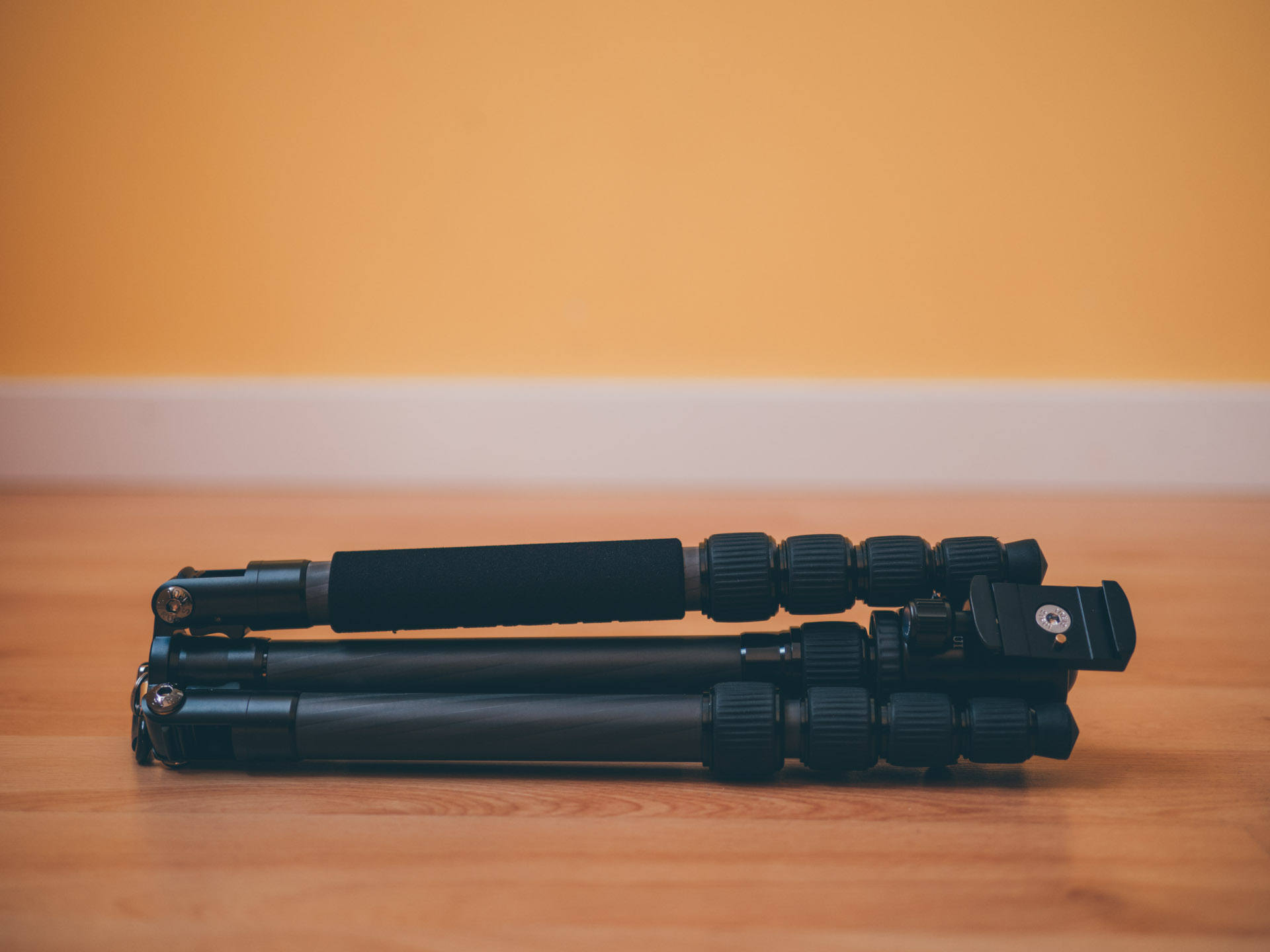
The T-025X is a remarkably light and compact travel tripod.
It also folds down to an impressive 11.8” (30 cm), almost exactly the same length as a 13-inch MacBook. This happy coincidence offers some very immediate possibilities, as it means the tripod will probably fit in your standard laptop bag without any issues, provided it’s deep enough. Keep in mind that shallower bags such as the Booq Mamba Slim Courier, which we’ve told you about before, may have a harder time holding the T-025X due to their extremely slim design.

The T-025X is just about the size of a 13-inch MacBook.
Additionally, the T-025X comes bundled with a light nylon carrying pouch, which you can sling over your shoulders if that’s your preference. In everyday use though, it’s often more comfortable to simply carry it in your bag with the rest of your gear.

The SIRUI T-025X comes with a nylon carrying bag.
Perhaps even more impressive than its compact size and light weight is the fact that the T-025X doesn’t compromise when it comes to its maximum load capacity. The solid carbon fiber construction enables it to withstand a maximum load of 13.2 lb (6 kg). That’s enough to easily support almost any camera and lens combination, from mirrorless setups to full-blown DSLRs. It’s even been tested with massive telephoto lenses like the Sigma 500mm f/4.5 and it was perfectly capable of holding it without breaking a sweat. Bottom point is, you needn’t worry about your gear when using this tripod. No matter what you throw at it, the T-025X will handle it with grace.

The T-025X with a Canon EOS 3 35mm film SLR camera.
Understandably, travel tripods are generally not among the tallest tripods out there, and the SIRUI T-025X is no exception. Still, when fully extended, it reaches a very respectable maximum height of 54.5”, or just over 138 cm. That’s a reasonably comfortable working height for most situations, but if you’re a tall person using a DSLR with an optical viewfinder, you’ll need to lower yourself a little bit to be able to peek through it. Travel tripods work better with mirrorless cameras with electronic viewfinders and tilt-down LCD screens, as they allow you to comfortably frame the shot from a standing position. In those situations, the T-025X excels.

The included C-10X ballhead.
One potentially divisive aspect of the T-025X is that it comes bundled with SIRUI’s own C-10X ballhead, something that is not common at all, particularly at this price point. Most people will certainly see that as a nice touch, while others may prefer to use a different ballhead instead. In that case, you’ll need to purchase it separately, and this is where things get a little trickier. Much like camera lenses, ballheads can be surprisingly expensive. The C-10X ballhead alone, for example, usually retails for $79.95. Unfortunately, SIRUI doesn’t sell the tripod without a ballhead so there’s no way to offset the C-10X’s cost when purchasing it. It would be nice to have more buying choices, but at the end of the day, the C-10X is an excellent ballhead, and you probably won’t feel inclined to replace it anytime soon.
Finally, the SIRUI T-025X travel tripod comes with a generous six-year warranty. Tripods, by definition, are subjected to less-than-gentle treatment on a regular basis, so it’s nice to see a manufacturer standing behind their products with such confidence.

Cibeles Square, Madrid.
In a nutshell, the T-025X is one of the world’s most compact and lightweight full-size travel tripods, but what really sets it apart from the competition is its incredible balance of performance, features, portability and price. There may be some slightly lighter tripods out there, and tripods that can withstand more load. There are probably also taller tripods, and tripods that offer more stability. But you’d be hard pressed to find one that matches the T-025X in all those features at the same time, and even more hard-pressed to find another carbon-fiber tripod that can do all that at this price point.
Design and construction
The T-025X’s design in extremely well thought-out in order to maximize portability without giving up versatility in the process. To that end, the T-025X’s legs fold in on themselves, allowing it to be more compact than any other similarly specced tripods out there.
On top of that, the center column and the ballhead can be removed for the ultimate portability — just be careful not to lose them. This comes at the cost of convenience though, since the tripod will require some reassembly before being used. Still, if you’re traveling and need to squeeze even the last bit of space out of your bag, it’s nice to have this option. For everyday use, the difference is not dramatic and it’s probably best to leave them attached to facilitate quick deployment.

The ballhead can be removed to become even more compact.

Like the ballhead, the center column can be removed for the ultimate portability.
The main structure of the T-025X comprises three telescopic legs and a center, removable column. Each of the legs includes five retractable sections and can be independently locked into position at three different angles. This is enabled by three spring-loaded latches, each featuring three aligned indentations in order to ensure the consistent positioning of each leg. As you unfold the legs, these latches automatically lock into position with a reassuring ‘click’.

Each leg can be independently locked into position at three different angles.
The independently adjustable legs, coupled with the removable center column — which can also be extended — give the T-025X a plethora of possible working positions. This is useful when deploying it on uneven terrain because it allows the tripod to adjust to the angle of the ground, with the ballhead and the camera remaining upright.

You can adjust each leg to adapt to uneven terrain, with the camera remaining upright.
And with a minimum deployed height of just 4.3” (11 cm, without the ballhead), you can get the camera as close to ground level as you want, which is very useful for macro photography.
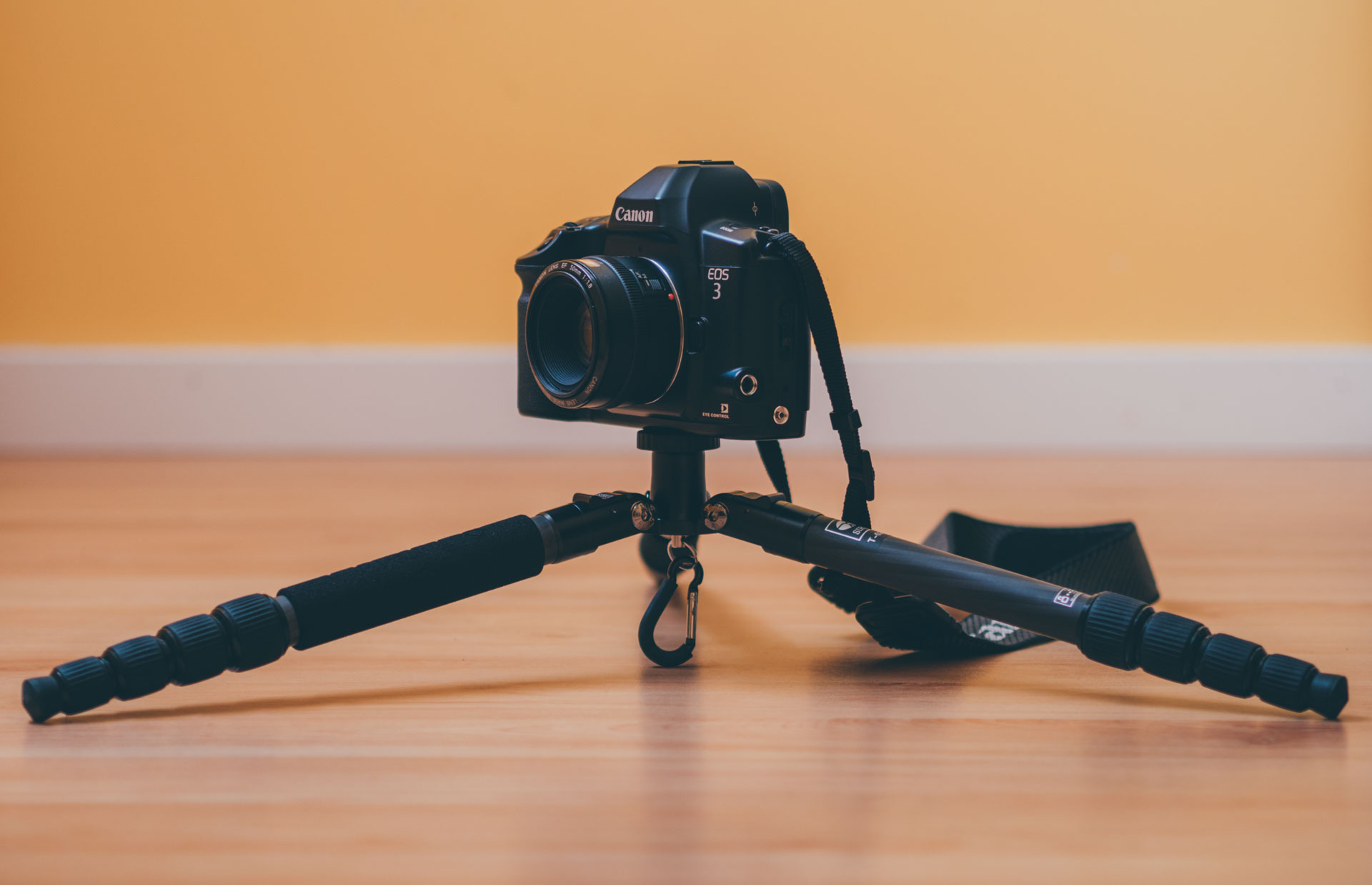
The T-025X at its lowest possible height.
Sometimes, deploying a tripod can be a cumbersome process and if we’re not able to do it quickly enough, we may miss some photo opportunities. To avoid this, the legs of the T-025X feature an ingenious twist-locking mechanism: by gripping and twisting all four rubber rings at the same time you can instantly deploy all sections, which is a very convenient feature. The same gesture works in reverse, allowing you to quickly retract the sections and lock them into place with a single, simple gesture. This is great design at work — the kind that makes life easier every day.

The twist-locking rubber rings allow for instant deployment.
The legs and the center column of the T-025X are where the magic happens. They’re made out of carbon fiber, using an 8-layer construction technique that SIRUI developed in-house. They offer just the right amount of stiffness to erase any concerns about their strength, and they’re styled in an attractive slate/graphite color pattern. This carbon fiber construction is what allows the T-025X to carry such an impressive load while remaining one of the lightest tripods on the market.
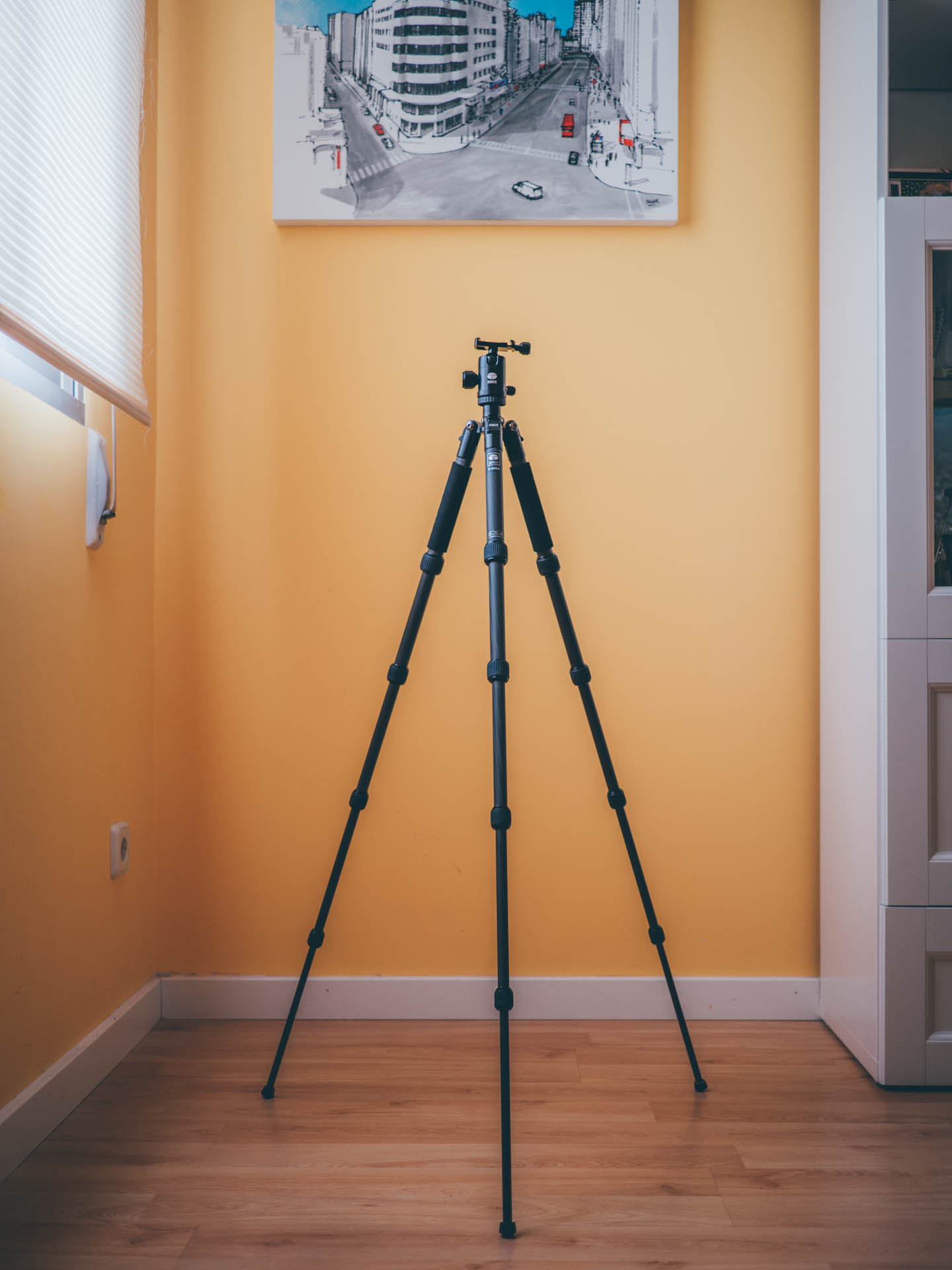
The T-025X travel tripod deployed without the center column.

T-025X with center column attached, but not extended.
The tripod has pointy rubber caps for feet, which are unfortunately fixed. As such, they cannot be replaced by spikes or any other anchoring mechanisms to handle some of the more uncertain gripping conditions like ice, for example. In practice though, they provide sufficient gripping power to keep the T-025X stable in most situations.
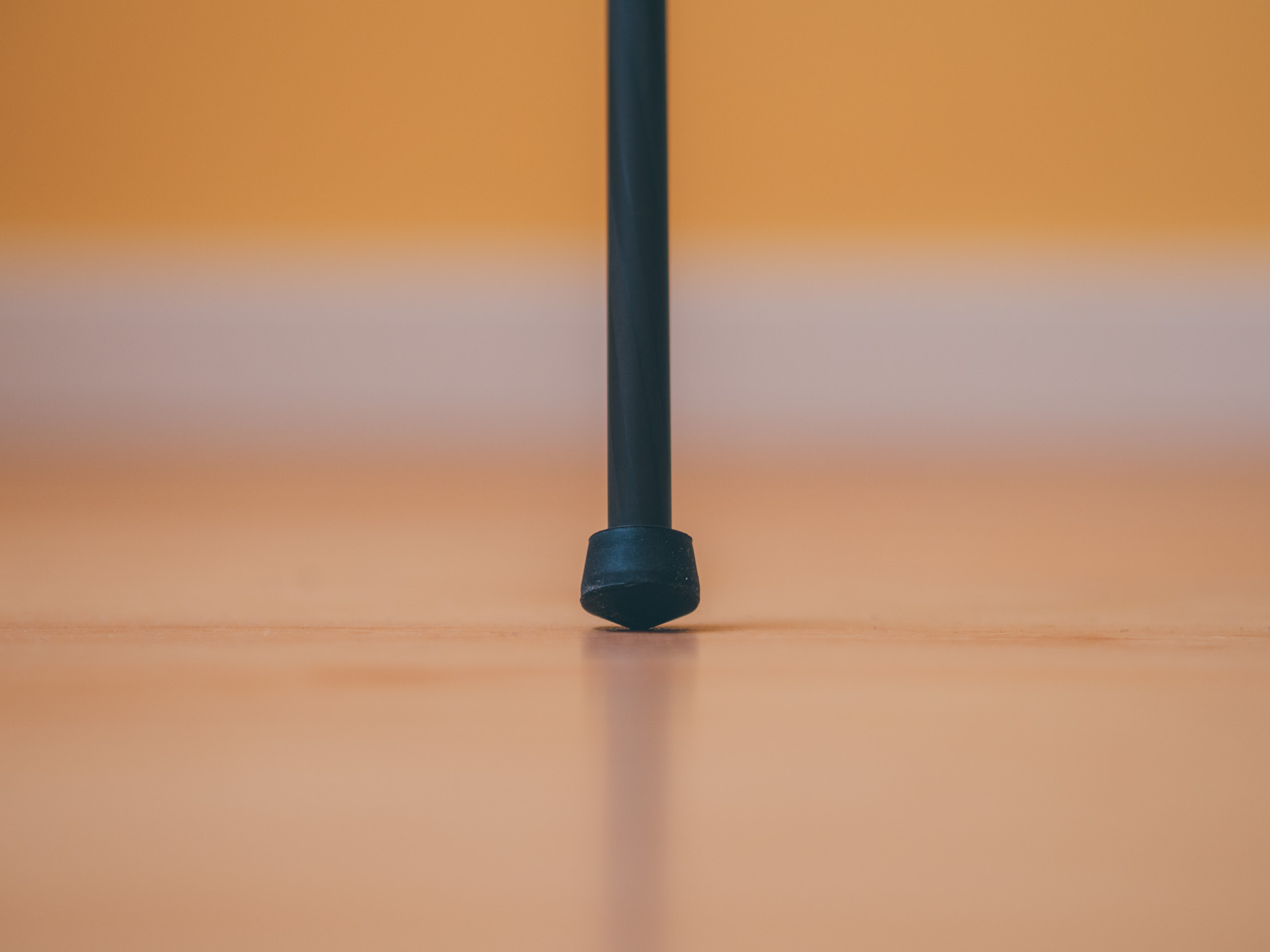
The feet are pointy rubber caps, and they can’t be replaced.

The feet are pointy rubber caps, and they can’t be replaced.
Two of the T-025X’s legs are covered by foam grips, to make them easier to grip in any slippery situations that may otherwise cause our gear to unceremoniously meet the ground. These foam grips feature engraved SIRUI inscriptions, which do nothing more than add branding to the product.

Two of the legs have foam grips with the SIRUI name on them.
Speaking of which, if there’s one thing the T-025X’s design doesn’t have is subtlety when it comes to branding. For such a small device, the SIRUI name is all over the place: besides the two etched inscriptions on the foam sections mentioned above, there’s a sticker (thankfully removable) with the SIRUI logo and the T-025X model number on the other leg. On top of that, there’s a SIRUI engraving on each of the leg clips, the quick-release mounting plate and of course, a quite prominent SIRUI logo on the ballhead. Even the bolts have SIRUI engravings on them. None of those are so blatant as to be off-putting, but it would have been nice to see a more understated, minimal approach to branding. It definitely would have been a better match for the T-025X’s otherwise sober, functional design.

The center column screws right into the main structure.
The center column is built to the same standards as the legs, including a rubber twist-locking ring to extend its second section. It screws right into the main structure for easy attachment and removal.

Center column, attached.
The T-025X also includes a threaded plate with a reversible bolt. This bolt has a constant 3/8” end that screws into the ballhead, and a tapered 3/8” -> 1/4” end that enables the camera to be attached directly to the center column or even the main structure, without the ballhead. By simply twisting the plate it is possible to unscrew the bolt and reverse its position. This is a very convenient feature, as the reversal can be performed without any tools.
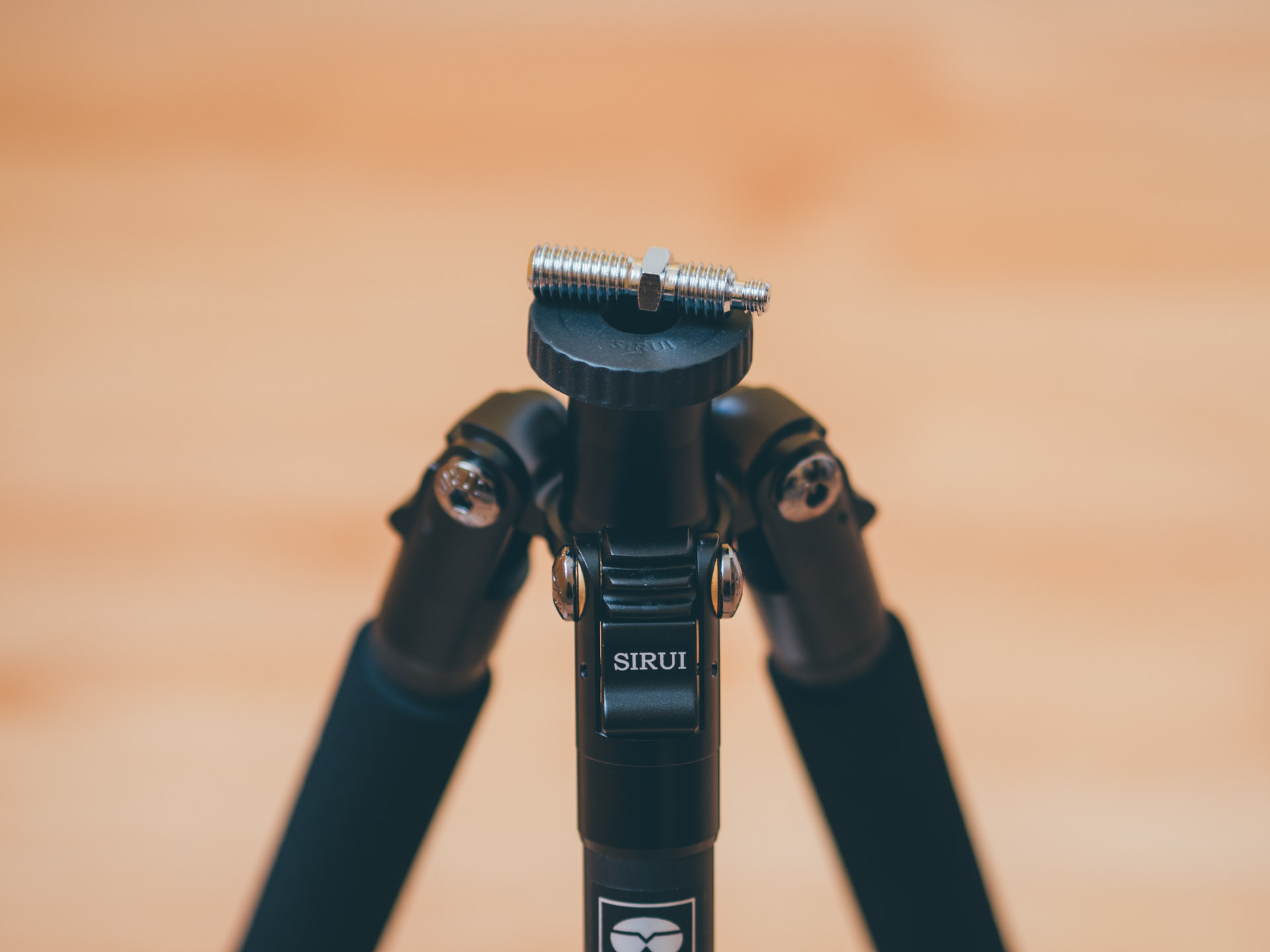
Threaded plate with reversible bolt.

Threaded plate with bolt attached for use with the ballhead.
As with any tripod, the T-025X will be more stable with a lower center of gravity. To that end, there’s a keyring directly below the center column, which is where the included carabiner is supposed to be attached to act as a weight hook. This allows us to clip our camera bag, a water bottle or any other moderately heavy objects on to the hook in order to increase the overall load while at the same time bringing the center of gravity of the entire structure down. This results in increased stability and robustness, which helps the tripod stay put in difficult situations, such as with strong winds, etc.
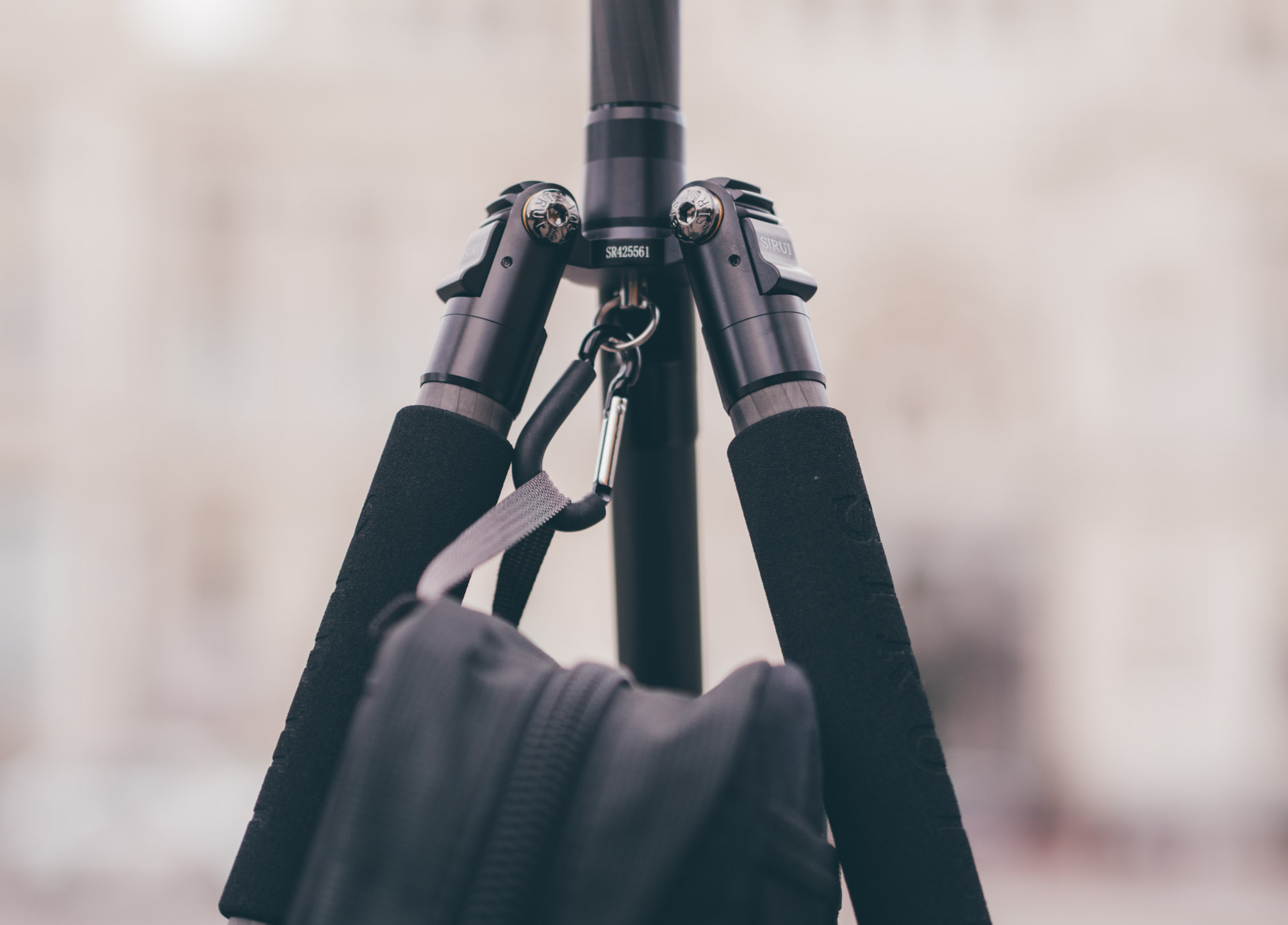
Weight hook with bag attached.
The rest of the structure is made out of machined aluminum, which helps keep the overall cost down while providing enough structural rigidity. Overall, the T-025X features a very robust design that plays perfectly to its strengths and is expertly optimized for the mobile photographer, for whom lightness and versatility are paramount. Besides, there are no glaring weaknesses that could compromise the safety of our gear, which is definitely appreciated.

Center column extended for maximum reach.
The C-10X ballhead
Perhaps one of the more controversial design decisions was the inclusion of the C-10X ballhead. It’s a solid performer, but there are certainly some lighter alternatives on the market. That’s why it seems odd that SIRUI decided to bundle a relatively hefty ballhead with the T-025X, a tripod that first and foremost emphasizes lightness and portability.
Now, it’s true that a tripod is only as stable as its ballhead. The T-025X is rated to withstand over thirteen pounds of weight, so it makes sense that SIRUI didn’t want to cut corners with the ballhead and chose to include it despite the additional weight. This may be interpreted as a sign of SIRUI’s commitment to quality and, if that’s case, it’s a welcome departure from the rest of the industry.

C-10X ballhead with built-in angular scale.
The C-10X is made out of anodized aluminum and features two knobs in the lower region, opposite each other. The bigger knob is the main tension control knob, and allows you to freely rotate the ball and the mount in order to lock them at your desired position. The smaller knob is the panoramic lock which, together with the angular scale at the bottom part of the body, allows you to smoothly change the angle of the camera to capture shake-free panoramas. Both knobs are made out of machined aluminum and feature indentations, which make them easy to grip even when wearing gloves.

The C-10X’s knobs are made out of high-precision machined aluminum.

The panoramic lock is located opposite the main tension knob.
The C-10X’s body also features a vertical notch, which allows you to turn the ball sideways and lock the camera into portrait orientation, eliminating the need for a separate L-plate. Of course, a proper L-plate will still provide more stability but this is a neat little trick and in a pinch, it works great.
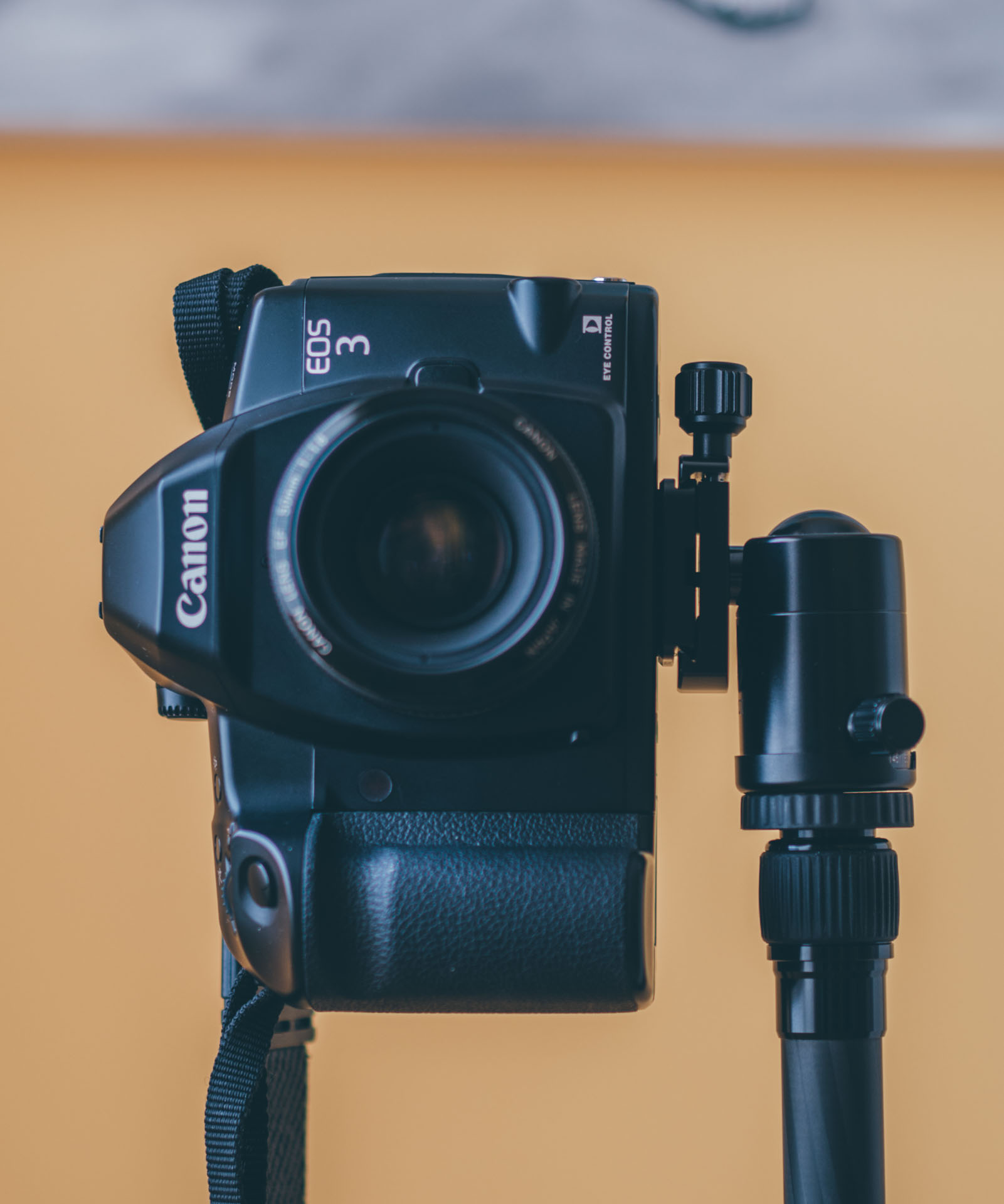
C-10X ballhead with camera in portrait orientation.
The ball itself is a 29 mm anodized aluminum ball, and provides smooth and frictionless motion when the tension control knob is loose. Twenty nine mm is a bit on the small side for this kind of ballhead, but it’s more than adequate for most needs.

Mount with included quick-release plate.
Additionally, the mount features a third similarly styled knob, which locks the quick-release mounting plate in position. Further, there’s a safety pin in the upper region, which will ensure the camera doesn’t fall even if the knob is somewhat loose. This little feature provides extra peace of mind when attaching and releasing the camera.
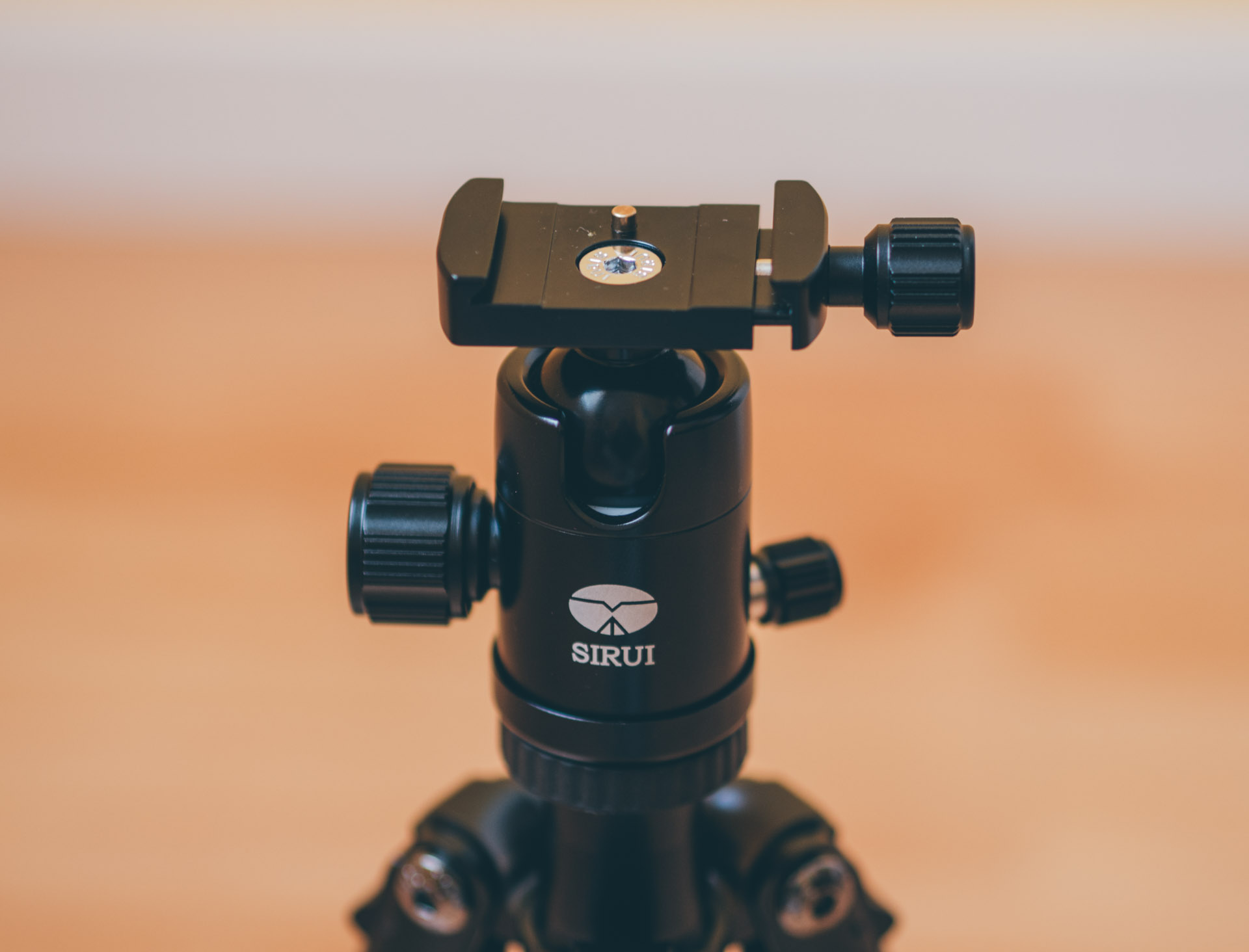
Mount with safety pin.
The T-025X includes SIRUI’s own TY-C10 Quick Release Plate, which is another welcome addition to the bundle. This is a rather small quick release plate, but it will work with most cameras without any issues.

The quick-release plate is fully Arca-Swiss compatible.

The quick-release plate is rather on the small side, but works surprisingly well.
Finally, another small but important feature of the C-10X’s mount is its full Arca-Swiss compatibility. If for some reason you’re not a fan of the bundled quick release plate, you can always use your preferred Arca-Swiss-compatible plate instead.
Real-world usage
In practical use, this tripod behaves extremely well. It’s light enough to always come along for the ride without weighing down your bag, and stable enough that you can confidently rely on it under most conditions, except perhaps the most severe winds.

T-025X travel tripod in use.
Being so light by design, the ability to attach a weight bag when the situation calls for extra stability is a welcome addition. In particular, owners of lighter mirrorless setups will benefit greatly from this feature on a regular basis.
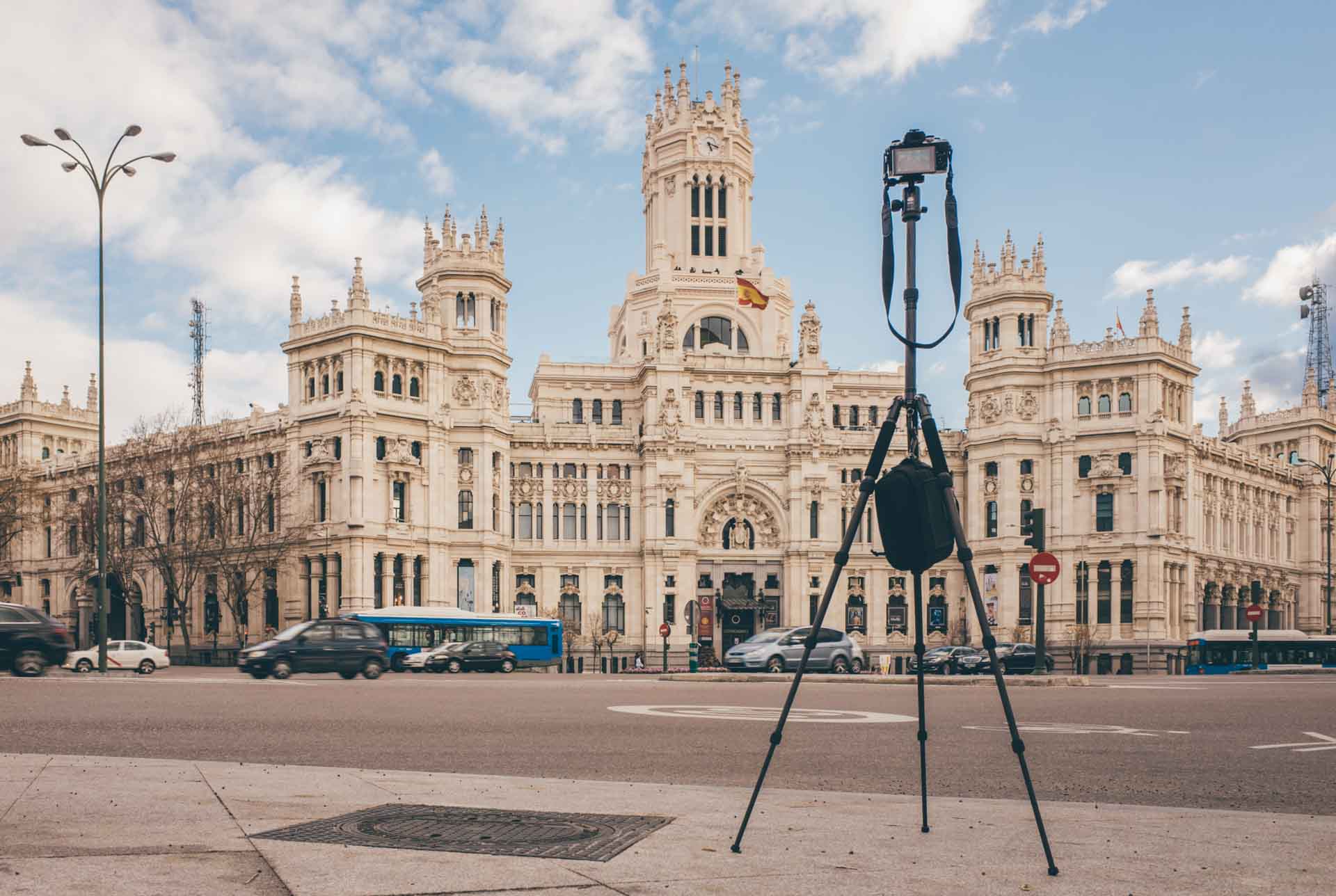
T-025X with weight bag in use.
In any case, whether you attach a weight bag or not, the use of a remote trigger is highly recommended, to ensure no vibrations are transmitted to the camera when pressing the shutter release button. Luckily, there are about a million inexpensive cable remote triggers available for every Canon and Nikon DSLR ever made. As for mirrorless cameras, all major manufacturers have been including WiFi in their camera bodies for a while, so chances are you’ll be able to use a smartphone app to trigger the shutter release. And if you own one of the older mirrorless cameras, you can always fall back on the trusty cable remote.

Puerta de Alcalá at night, Madrid.
Long exposures are a breeze to set up with this tripod. The T-025X does a wonderful job of keeping everything nice and sharp while capturing motion, and the resulting images are always flawless.

Metrópolis Building and Gran Vía at night, Madrid.
Finally, its solid carbon fiber construction provides plenty of supporting power, as well as great protection against temperature variations. Carbon fiber is a much better thermal insulator than aluminum, which means the tripod will remain reasonably warm to the touch, even in extremely cold weather. Think of it as the equivalent of weather sealing for your tripod. If you’ve ever been shooting out in the cold, you probably know that touching a frozen piece of metal with your bare hands is not a pleasant experience, so it’s definitely nice to use a tripod that will protect the integrity of your fingers.

Small fountain at Sabatini Gardens, Madrid.

Santander Park fountain, Madrid.
Quirks and annoyances
As great as the T-025X is most of the time, it’s not without its flaws. Here are some of the things that could be improved, and that would take what is already an excellent tripod to the next level.
The most glaring omission, and the one that will regularly affect most users is the lack of a bubble level. This is such a basic feature that it’s quite surprising to find it missing, particularly when almost every entry-level tripod out there has it. If you own a modern mirrorless camera, chances are the electronic viewfinder has a built-in level powered by the internal accelerometer (the one that’s used to flip the LCD’s image automatically when you rotate the camera from landscape to portrait orientation). If that’s the case, you can use it as a poor substitute for a true bubble level. If, on the other hand, your camera doesn’t have this feature, there are some cheap aftermarket levels than can be used with the T-025X. In any case, these solutions are mere hacks, and remain far from being acceptable for a product in this category.

Without a bubble level, there’s no way to know when your camera is correctly aligned.
Another potentially annoying quirk is related to the bolt that locks the quick-release plate to the camera. It doesn’t include a built-in D-ring for easy manipulation, which means you’ll need to use a coin, a flathead screwdriver or one of the supplied Allen wrenches to screw the plate onto your camera. This makes attaching and releasing the plate a bit more cumbersome than it needs to be. The easiest way to cope with it is to simply leave the plate attached to your camera at all times, but this is far from ideal. If you own more than one camera, your only alternatives are to replace the bolt altogether (there are plenty of compatible bolts with built-in D-rings on Amazon) or to buy an additional plate for each of your cameras. Neither of these solutions is particularly convenient, and for a product that otherwise exhibits excellent design chops, this is an unfortunate omission.

The bolt that comes with the mounting plate does not have a built-in D-ring.
The non-removable feet could also benefit from a slight redesign. As mentioned before, while the supplied rubber caps do a perfectly good job of stabilizing the tripod in most situations, it would still be better if SIRUI had incorporated a way to replace them for different anchoring mechanisms like spikes, to better adapt to a wider range of conditions. A tripod’s feet are rather important for the overall stability of the device, and it’s too bad SIRUI didn’t think to include such a feature in the T-025X. It does raise some concerns about their durability, since they’re probably the part that suffers the most wear and tear in everyday use.

The non-removable rubber feet work well, but raise some concerns about their durability.
Another thing that would have been nice to see is the ability to attach the center column to one of the legs in order to be used as a monopod. Admittedly, not many tripods have this feature, but it does come in handy on occasion, and it would have been a welcome addition.
Finally, the last minor inconvenience is caused by the supplied carabiner that acts as a weight hook. While it’s clearly solid enough and the protective padding is adequate, the opening is so small that clipping anything to it can easily become an exercise in frustration. This is particularly true if your dexterity is somewhat impaired by cold weather, for example. If you can get used to working with it, there’s probably no need to replace it. Should you want to though, you’ll be pleased to know that pretty much any standard carabiner will work just as well.

The weight kook is sometimes hard to get to, and its opening is rather small.
None of these issues can be considered critical, and they’re certainly not deal-breakers, but they do leave some room for improvement. In any case, most of these quirks are easily solvable or can be worked around in some way, so they don’t change the status of the T-025X as a great travel tripod.
Versus the competition
The main competitors of this tripod are the Manfrotto BeFree, the Mefoto Backpacker, the Gitzo Traveler GT1542T, and SIRUI’s own T-005X travel tripod. Let’s see how each of these stacks up against the T-025X.
The Manfrotto BeFree is a bit more affordable than the T-025X, coming in at just under $200. However, it compares poorly to it by almost every other metric. The BeFree is made out of aluminum (vs. carbon fiber), is not as compact (15.8” vs. 11.8”), doesn’t get as close to the ground (13.4″ vs. 4.13”), is able to carry less weight (8.8 lb vs. 13.6 lb) and is more than three times as heavy (5.3 lb vs. 1.43 lb). It does reach a bit higher, though (56.7” vs. 51.18”). It’s overall a nice tripod, but it’s too close in price to the T-025X to be considered a good investment.
The Mefoto Backpacker, at $136, is considerably cheaper than the T-025X, and is reasonably close to it in terms of features as well. It’s a bit less compact (12.6” vs. 11.8”) and a quite a bit heavier (2.6 lb vs. 1.43 lb), but it can still be considered a light tripod. It does have a built-in bubble level, but it can’t compete with the T-025X in loading capacity (8.8 lb vs 13.6 lb) and is less versatile as well, since its center column can’t be removed. If you own a lighter mirrorless system and you can live with a somewhat heavier and less compact tripod, take a good look at the Backpacker, although you’ll probably still prefer SIRUI’s more affordable T-005X model over this one.
The Gitzo Traveler GT1542T is the entry-level model in Gitzo’s Traveler range. Still, it’s not exactly affordable, coming in at $679. That price tag alone will be enough to disqualify it for some, which is perfectly understandable. For that kind of money, you do get a carbon fiber tripod that reaches higher and can carry more load than the T-025X, but not by much. On the other hand, it doesn’t fold nearly as compact, being a full 6 inches longer than the T-025X when closed. It’s also heavier than the SIRUI tripod and can’t get as close to the ground, so it’s not immediately obvious which one is the better pick, even when leaving price aside. The fact that the T-025X can stand toe-to-toe with such high-end competition just goes to show what an amazing value it is.
The toughest competitor of the T-025X is, ironically, SIRUI’s own T-005X travel tripod. It’s basically identical to the T-025X, only it’s made out of aluminum instead of carbon fiber. As such, it has the same dimensions and reaches the same maximum and minimum heights, but it’s slightly heavier (1.76 lb vs. 1.43 lb) and can support less load (8.8 lb vs. 13.6 lb). Another potentially important difference is that the T-005X will not hold up as well in extreme weather due to the inferior thermal properties of aluminum vs. carbon fiber. Other than that, both tripods share the exact same features, which makes the T-005X a terrific value for the money, since it’s usually about a full $100 cheaper than the T-025X. If you live in a place with mild weather and own a light mirrorless setup, the T-005X is certainly more than enough tripod for you. If, on the other hand, you want to have the opportunity to shoot under rougher conditions or need to carry a full-blown DSLR setup, the T-025X remains the better choice.

T-025X travel tripod in use.
Conclusion
As you’ve seen, one of the most remarkable things about the SIRUI T-025X is just how well-rounded it is as a product. Travel tripods are a very particular product category: they need to be small, light, sturdy and versatile. With the T-025X, SIRUI has proven that they know exactly what makes for a great travel tripod. The T-025X manages to tick all the right checkboxes in an impressive way, and it’s truly a fantastic tripod you’ll enjoy taking with you anywhere. Yes, there are sturdier tripods out there, and tripods that can reach higher, but there’s no other tripod (at least not that we could find) that can match the overall performance and feature set of the T-025X, definitely not a similar price point.

T-025X travel tripod with Canon EOS 3 film SLR.
On an industrial level, with the T-025X — and the T-005X as well — SIRUI is proving they’re serious about changing the public’s perception of Chinese manufacturers, particularly when it comes to competing in premium categories. They still have a way to go, but it appears they’re on the right track, and they will only get better in the future. It’s great to see that a huge manufacturer can prioritize design and quality and still be successful, and it gives us hope for the rest of the industry.
If you’re in the market for a travel tripod, look no further than the SIRUI T-025X. It may not be perfect but, if you’re more interested in taking pictures than in obsessing over your gear — as you should be — it’s close enough.
